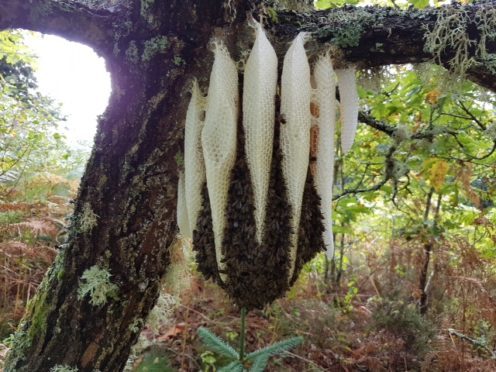Aberdeenshire beekeepers are helping to save the Scottish honey bee by taking part in a new national study.
The Tarland Bee Group was alerted to a wild swarm of natives found near Aboyne last October and members were “amazed” to find that it had managed to build combs and survive the colder weather outside.
Now the apiarists are nurturing the wild creatures and are preparing to send samples off to the Scottish Native Honey Bee Society (SNHBS) in the hope they will be rearing queens.
Aboyne teenagers picked to represent Scotland at beekeeping competition
Scotland’s own native honeybees are under threat from disease and other species imported from abroad.
The Scottish Native Honey Bee Society (SNHBS) has this month launched a new project which aims to take a significant step towards identifying the type of flying insects across the country.
Native bees could then be used for breeding to help ensure their survival.
Yvonne Davidson from the Tarland Bee Group said she had been sceptical at first when she had received a call from retired beekeeper David Jenkins about a wild swarm near his house in Aboyne.
“I couldn’t believe it when we found them,” said Mrs Davidson. “They had been surviving in the wind and rain.
“It was amazing to see. Usually they would find somewhere inside to build combs, but they had built seven on the branch of a tree.”
The Scotland-wide survey invites beekeepers to submit photographs of their stocks which resemble our dark native species.
After being identified by experts, those showing the closest conformance will be put forward for DNA analysis.
The SNHBS comprises volunteers from across the hobby and commercial bee-keeping community in Scotland keen to help promote the conservation and study of the native honey bee.
A spokesman said: “Scottish native honey bees are a brown bee with a reputation for frugality which helps them withstand even the dreichest of Scottish weather.
“But, like the Scottish Wildcat, it has been getting increasingly difficult to find good pure examples and if we don’t take action to reverse their decline we may see them disappear forever.
“Ironically some of the problems facing the Scottish bee, come from the resurgence of bee-keeping hobbyists, as many of the bees available to them are derived from imported stocks of non-native bees and when these cross with our native strain it begins to dilute the authenticity of the true Scottish strain.
“Pests new to the country, such as the devastating Varroa mite which arrived in 1992, are likely to have made it into this country in imported stocks. In the last 20 years Varroa has almost completely eradicated wild honey bees in
Scotland and has significantly reduced native bee numbers.”
Information on how to enter the survey can be found: www.snhbs.scot
